Introduction
Odisha is predominantly an agricultural state with a cultivated area of 90.54 lakhs ha and average production of 25.44 million tons.1 Koraput is situated 180.48’ 48.5532’’N latitude and 820.42’ 44.3988’’E longitude, the average rainfall is 1505.8mm (District Statistical Handbook), Out of 51649 geographical area the irrigated area covers 5503 hectares, rain fed 14246 hectares. The soil type is matured red and lateritic mixed grey soil, annual rain fall 1521.8 with an average of 84 rainy days. The district economy mainly depends on agriculture and which mainly depends on rainfall. The rainfall depends on South-West monsoon. Out of total cropping area of 296000 ha in Koraput, irrigation potential in Kharif is 30.71% and in Rabi is 21.51%. Generally crops grown during rabi namely paddy, wheat, maize, finger millet, green gram, black gram, groundnut, mustard, field pea, sunflower etc. needs assured irrigation
Koraput district is contiguous with the main land of Eastern Ghats, having 24 % land under forests cover. The district experiences a dry sub-humid climate with dry summers and cool winters with mean maximum & minimum temperate of 30.6oC and 17.03oC respectively. April and May are the hottest months and December and January are the coolest months. The area falls under the Eastern Ghats high land agro-climatic zone having the ecological situation of high elevation and medium rain fall.
Koraput is one of the 69 districts of India identified as being notably disadvantaged regarding poverty, hunger, infant mortality, immunization, literacy, school enrolment and gender disparity. Once covered with dense forest that supported hunting and gathering, in addition to “shifting cultivation” agriculture, mineral-rich Koraput district is undergoing rapid deforestation and incursion by mining interests, hydroelectric dams and other development projects. Climate change has impacted the tribals’ traditional agricultural methods on the uplands, resulting in erosion and decreasing crop yields. Many are obliged to migrate for work during non-agricultural seasons, yet exploitation of labourers undermines this survival strategy as well. Monsoon is the most critical time. Food stores from last year’s harvest are depleted but crops have not yet matured in the current season.
Tribal people mainly depend upon rainfall for their agriculture and kharif paddy is the only source of income for them for many years. They used to purchase vegetables from the local markets and household consumption was not balanced. To supplement this situation, M.S. Swaminathan Research Foundation in one of its project Mahila Kisan Sashaktikaran Pariyojana (MKSP) took new initiatives to empower the women to cultivate vegetables in their backyard on a pilot scale.
“Purchasing vegetables from local markets was a nightmare and very expensive. The markets are only weekly markets and very far from our household. So we restricted to consume ragi gruel and ragi based foods and less nutritive foods”
|
Materials and Methods
Kitchen gardens were based on a model called Annadata Kitchen Garden, which is a structured garden with multiple crops. This was practiced from 2013 onwards and helped to consume more vegetables and fruits in their daily household consumption. Their dietary habits have changed due to this intervention.
“I have been practicing paddy cultivation in the lowlands and millets in the uplands for our survival. Cost of cultivation in paddy is more than any other crop and depends on monsoon as we don’t have irrigation facility. Agriculture was a gamble until we started practicing vegetable cultivation in our backyards”
|
Kitchen gardens are common in India, which serves as an additional source of income and caters to the daily household nutritional needs of the rural family. However a structured garden with multiple crops including annuals, perennials with a mix up of vegetables, fruits and flower crops has its own advantages over a mono-cropping system.
Vegetables are rich source of nutrition which contains carbohydrates, protein, minerals and multi vitamins.2 This helps to fight against anemia, malnutrition and hidden hunger.3 India is the second largest producer of vegetables in the world4 and in particular over past couple of years, Odisha has been witnessing a substantial rise in prices of vegetables. This is giving a positive incentive to increase production, productivity and quality of produce.5
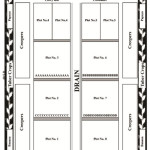 |
Plate 1: Annadata Layout |
Why Annadata kitchen Garden Model of Vegetable cultivation?
Vegetable cultivation requires less water than paddy as Koraput district is purely rain fed and the profit margin is more with less care and attention. Women SHGs, individuals, farm families were growing vegetables which is an appropriate supplement for their dietary food habit. However, the garden was not organized and it was mono-cropping. M. S. Swaminathan Research Foundation introduced a unique model called Annadata Kitchen Garden Model which is a structured model with a diversity of crops (Plate 1; Figure 1) suited to all the seasons rainy, winter and summer which was not prevalent earlier. The available backyard land of size 5, 10 and 20 cents was utilized for the above purpose. The crops ranged from leafy vegetables to spices covering the entire basket of food and balanced their nutritional demands.
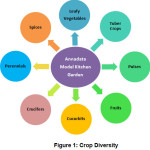 |
Figure- 1: Crop diversity |
Moreover it is cultivated in a purely organic mode with a bunch of sustainable technologies such as use of bio in puts and natural resources. This was compared with conventional or non-IPM growers and the diversity of insect pests and its natural enemies showed a wide variation (vide results and discussion Table 1).
Annadata kitchen garden has been designed in the rural outskirts of Kundra and Boipariguda Blocks. Nuaguda, Jholaguda, Kharaguda, Pialkani, Khutguda, Chiliguda, Munja, Santaliaguda, Tentulipar, Chendia jhilligaonare few prominent villages which practice this model in an organic mode from 2015. Till date there are 329 units of such garden. The gradual increase and replication clearly shows that Mahila Kisans was impressed with the model. The penetration of such viable units proves that they are successful, socially acceptable, environment friendly and caters to the wholesome dietary habits.
| Out of the discussion majority of the Mahila Kisans felt the importance of vegetable garden and came forward to take this on a pilot basis. They convinced their husbands and grew cauliflower or brinjal or lady’s finger as a monocrop in their 5 cents of land with an investment of just Rs. 950/-. After observing the benefit of the model, they expanded the practice to 10 (Rs. 1200/-) and 20 cents (Rs. 1860/-) in a structured layout as shown in the figure. |
The Annadata kitchen garden is grown throughout the season with a land holding size of 5, 10 and 20 cents. Summer, rainy and winter is the three seasons in which suitable crops are chosen. The predominant crops include high yielding varieties of brinjal, lady’s finger, cauliflower, beans, garden pea, onion, tomato, chillies, red gram, cabbage, carrot, leafy vegetables, curry leaf, coriander and intercropped with French marigold and French beans. In the border, on the fences creepers like bitter gourd, snake gourd, bottle gourd and tuber crop such as elephant yam are cultivated. papaya, drumstick, guava, sapota, acid lime is few perennials which are grown along the border. The layout (Plate 1) shows clearly how efficiently the space can be utilized with multiple cropping systems so that the income will be more from per unit area utilized.
Mahila Kisans were trained to grow Annadata Kitchen garden with a systematic procedure. 42 trainee days were covered during the first and second year of the project. 20 villages from each block were selected plus at present there are 329 units available. Farmers who were cultivating paddy in their uplands with more external inputs ended up with very meager yield. At this juncture the viable alternative solution was Annadata Kitchen garden units.
Sustainable Technologies – An Added Advantage
The tribal women added farmyard manure, vermicompost, kitchen waste compost during the last ploughing instead of inorganic fertilizers. For the management of pests and diseases as well as better growth, prophylactic application of botanical preparations made from local resources (neem and pongamia mixed in cow dung and cow urine) namely neemastra, agneyastra, handikatha, jeebamrita. These local organic bio in puts act as pest repellents, antifeedants and plant growth promoters.
Results and Discussion
Due to prophylactic spraying of bio inputs, installation of yellow sticky traps, erection of bird perches and intercropping with marigold as trap crop the incidence of pests reduced and beneficial species increased as against non-IPM practitioners (Table 1). There was less percentage of crop damage hence led to decent yield and income.
| Nilabati Khilo, 45 years old Mahila Kisan lives with her husband Mr. Madana Khilo at Jholaguda village, Lima Gram Panchayat of Kundra Block, Koraput district. She has gown about 10 varieties of vegetables along with few perennial crops6 as suggested by the MKSP project scientist. She doesn’t apply any chemical pesticides and chemical fertilizers in the garden but apply only bio-fertilizers and bio-pesticides7 like bio-compost, cow dung, Handi khata, Beejamruta, Jeebamruta, and Neemastra etc |
Table 1: Prevalence of Pests and their Natural Enemies in the IPM* and Non-IPM** Vegetable Garden
| Arthropod fauna | Population status | ||
| IPM adopters* | Non-IPM adopters** | ||
| Insect Pests | |||
| Leucinodes orbonalis | 2-3% damaged fruiting bodies; 1 larva per 10 plants; l damaged plant from 20 randomly selected plants | 30% damaged fruiting bodies; 1 larva per plant; 3 damaged plants from 20 randomly selected plants | |
| Helicoverpa armigera | 5% infested flowers and fruits | 10% infested flowers and fruits | |
| Amrasca biguttula | 1 jassid/nymph per five leaves; third grade jassid injury | 2 jassids/nymph per leaf; second grade jassid injury (yellowing in the margin of leaves) | |
| Bemesia tabaci | Less than 5 nymphs per leaf | 5-10 nymphs per leaf | |
| Beneficial insects | |||
| Parasitoids | |||
| Egg parasitoid | Trichogramma spp. | Absent | |
| Larval parasitoids | Campoletis chlorideae; Bracon hebetor, B. greeni, Apanteles sp.,1-2 cocoons/parasitized larvae per 5 plants | Absent | |
| Predators | |||
| Coccinellids | Cheilomenes sexmaculatus,Coccinella septempunctata,Cryptolaemus montrouzieriAnagyrus sp. 10 – 20 per 5 plants | Absent | |
| Dragon fliesDamsel flies | Pantala flavescensAgriochemis feminafemina – Abundant | 1 or 2 per plant | |
| Green lace wings | Chrysoperla carnea –5-10 adults per plant | 1 or 2 per plant | |
| Aranae | |||
| Spiders | Oxyopes sp., and Tetragnatha sp. – Numerous | ||
| Predatory birds | |||
| House sparrowBlack drongoCommon mynah | Passer domesticusDicrurus macrocercusAcridotheres tristis – Abundant | Absent | |
| Others | |||
| Earthworms | 60% population | 10-15% population | |
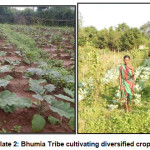 |
Plate 2: Bhumia Tribe cultivating diversified crops |
Out of the total 329 units of Annadata kitchen garden the results will focus on the average of randomly selected 62 units during three years namely 2015, 2016 and 2017. The crop diversity, production, household consumption and net income derived from the surplus sales are discussed below.
The production ranged from 38.29 Kgs, being the highest recorded in papaya to the least yield in drumstick (2.94 Kg) (Table 2). Earlier the rural community was dependant on external sources. At present they are able to consume 84.01 Kgs per season (approx. 4 months) during rainy days to a minimum of 49.17 Kg during summer (Figure 2). Overall it meets their nutritive demands as it was not a regular habit earlier. The dietary diversity was evident clearly which lead to reduction in malnutrition.9 The net income against the vegetables and fruits grown in the garden ranged from Rs. 35.08 to Rs. 491.61. Among the seasons it was proved that rainy season is the ideal over the others (Table 2; Figure 3).
Table 2: Comparative Production and Income Status of Annadata Kitchen Garden
| Year | Season | Crops | Production (Kgs) |
Consumption (Kgs) |
Sales (Kgs) |
Net Income (Rs) |
| 2015 | Rainy | Amaranthus | 17.95 | 10.77 | 7.18 | 143.7 |
| Beans | 20.16 | 10.96 | 9.22 | 276.77 | ||
| Lady’s finger | 22.04 | 11.88 | 10.16 | 254.03 | ||
| Radish | 18.66 | 10.8 | 7.85 | 78.54 | ||
| Green pea | 15.91 | 9.33 | 6.58 | 263.22 | ||
| Chillies | 8.17 | 3.29 | 4.88 | 146.61 | ||
| Ridge gourd | 17.72 | 10.54 | 7.17 | 143.54 | ||
| Papaya | 16.96 | 11.59 | 5.37 | 107.41 | ||
| Pulses | 7.82 | 4.85 | 2.96 | 178.06 | ||
| Winter | Amaranthus | 17.90 | 9.97 | 7.94 | 158.71 | |
| Beans | 21.10 | 12.74 | 8.35 | 250.65 | ||
| Tomato | 16.47 | 8.27 | 8.19 | 245.81 | ||
| Brinjal | 24.56 | 14.06 | 10.50 | 210.00 | ||
| Cauliflower | 22.15 | 11.19 | 10.95 | 328.55 | ||
| Papaya | 38.29 | 19.53 | 18.76 | 375.16 | ||
| Summer | Cucumber | 8.19 | 3.65 | 4.55 | 68.23 | |
| Ridge gourd | 20.48 | 10.81 | 9.68 | 212.90 | ||
| Bitter gourd | 8.39 | 4.58 | 3.81 | 57.10 | ||
| Brinjal | 14.56 | 9.65 | 4.92 | 98.39 | ||
| Amaranthus | 13.74 | 8.24 | 5.50 | 55.00 | ||
| Papaya | 19.60 | 12.24 | 7.35 | 176.52 | ||
| 2016 | Rainy | Amaranthus | 13.70 | 7.35 | 6.35 | 76.16 |
| Beans | 19.06 | 10.08 | 8.98 | 197.65 | ||
| Lady’s finger | 16.74 | 9.13 | 7.61 | 228.39 | ||
| Radish | 18.56 | 11.21 | 7.35 | 132.39 | ||
| Green pea | 15.65 | 9.47 | 6.18 | 123.55 | ||
| Chillies | 10.53 | 6.50 | 4.03 | 120.97 | ||
| Ridge gourd | 16.39 | 8.68 | 7.71 | 115.65 | ||
| Papaya | 37.61 | 19.26 | 18.35 | 330.39 | ||
| Pulses | 5.71 | 3.87 | 1.84 | 58.84 | ||
| Winter | Amaranthus | 12.00 | 6.44 | 5.56 | 55.65 | |
| Beans | 16.90 | 9.68 | 7.23 | 158.97 | ||
| Tomato | 16.63 | 8.84 | 7.79 | 116.85 | ||
| Brinjal | 13.56 | 6.52 | 7.05 | 140.97 | ||
| Cauli flower | 18.45 | 10.97 | 7.48 | 112.26 | ||
| Chillies | 9.92 | 3.44 | 6.48 | 162.10 | ||
| Papaya | 21.58 | 12.58 | 9.00 | 180.00 | ||
| Drumstick | 2.94 | 1.53 | 1.78 | 35.08 | ||
| Summer | Cucumber | 8.97 | 4.73 | 4.24 | 50.90 | |
| Ridge gourd | 20.08 | 10.73 | 9.35 | 168.39 | ||
| Bitter gourd | 8.06 | 4.60 | 3.47 | 62.42 | ||
| Brinjal | 14.55 | 9.48 | 5.06 | 111.42 | ||
| Amaranthus | 12.29 | 6.89 | 5.40 | 54.03 | ||
| Papaya | 32.03 | 17.27 | 14.76 | 368.95 | ||
| 2017 | Rainy | Amaranthus | 16.92 | 8.47 | 8.45 | 84.52 |
| Beans | 14.53 | 7.48 | 7.05 | 126.87 | ||
| Lady’s finger | 14.42 | 6.97 | 7.45 | 186.29 | ||
| Radish | 16.22 | 8.68 | 7.54 | 90.48 | ||
| Green pea | 18.13 | 10.19 | 7.94 | 158.71 | ||
| Chillies | 8.00 | 3.44 | 4.56 | 114.11 | ||
| Ridge gourd | 17.18 | 8.29 | 8.89 | 133.31 | ||
| Papaya | 18.23 | 11.79 | 6.44 | 96.53 | ||
| Pulses | 8.84 | 7.11 | 1.73 | 103.55 | ||
| Winter | Amaranthus | 11.61 | 6.60 | 5.02 | 70.23 | |
| Beans | 16.84 | 9.92 | 6.92 | 138.39 | ||
| Tomato | 24.18 | 13.40 | 10.77 | 107.74 | ||
| Cauli flower | 20.24 | 11.08 | 9.16 | 146.58 | ||
| Chillies | 8.79 | 4.23 | 4.56 | 68.47 | ||
| Papaya | 35.24 | 18.85 | 16.39 | 491.61 | ||
| Summer | Cucumber | 10.53 | 4.75 | 5.78 | 70.66 | |
| Ridge gourd | 21.51 | 14.23 | 7.28 | 207.34 | ||
| Bitter gourd | 11.20 | 5.53 | 5.67 | 48.33 | ||
| Brinjal | 13.71 | 6.38 | 7.33 | 94.34 | ||
| Amaranthus | 14.14 | 7.67 | 6.47 | 44.89 | ||
| Papaya | 23.62 | 14.38 | 9.24 | 183.22 |
* Values are mean of 62 Annadata Kitchen Garden Units
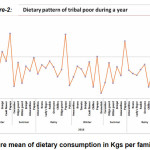 |
Figure 2: Dietary pattern of Tribal poor during a year |
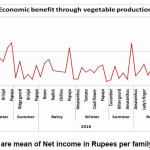 |
Figure 3: Economic benefit through vegetable production |
Conclusion
The Annadata kitchen garden includes usage of diversified seeds and improved sustainable farming practices. Adoption of this model at household enhances access to vegetables and fruits, increases skill sets in usage of sustainable agricultural practices and utilization of nutri-dense foods and also provides additional income generation activities and such model can be promoted for replication in similar ecological and social condition.
Acknowledgements
The authors sincerely thank MORD and OLM for the financial support. Our special thanks are due to Dr V. Selvam, Executive Director, MSSRF, Chennai for motivation. Special mention of appreciation goes to Mahila Kisans who co-operated and adopted the technology.
References
- Agricultural Statistics of Odisha, 2013.
- nios.ac.in/SecHmscicour/english/LESSON_02.pdf.
- Johnson-Welch C, Alemu B, Msaki TP, Sengendo M, Kigutha H, Wolff A: Improving Household Food Security: Institutions, Gender and Integrated Approaches. Davis CA, USA: Paper prepared for the Broadening Access and Strengthening Input Market Systems (BASIS) Collaborative Research Support Project (CRSP). 2000.
- Vanitha, S.M., S.N.S. Chaurasia, P.M. Singh and Prakash S. Naik. 2013. Vegetable Statistics.Technical Bulletin No. 51, IIVR, Varanasi. 250.
- “Value Chain Study for Vegetable Subsector in Malkangiri, Koraput, Rayagada and Nawarangpur Districts of Odisha” 2014. Mahila Kisan Sashaktikaran Pariyojona. A Report by: Access Livelihoods Consulting India Ltd. Secunderabad -03, Telangana
- org/wp-content/uploads/…/Organic-Farmers-and-Farms-in-Andhra-Pradesh.pdf
- in.undp.org/content/dam/india/docs/pub…/MKSP-Handbook.
- Huang, T. 2014. Narrative review of dietary diversity tools and qualitative exploration of changes in dietary variety in Kolli hills, India. M.Sc. Thesis, University of Alberta.

This work is licensed under a Creative Commons Attribution 4.0 International License.







